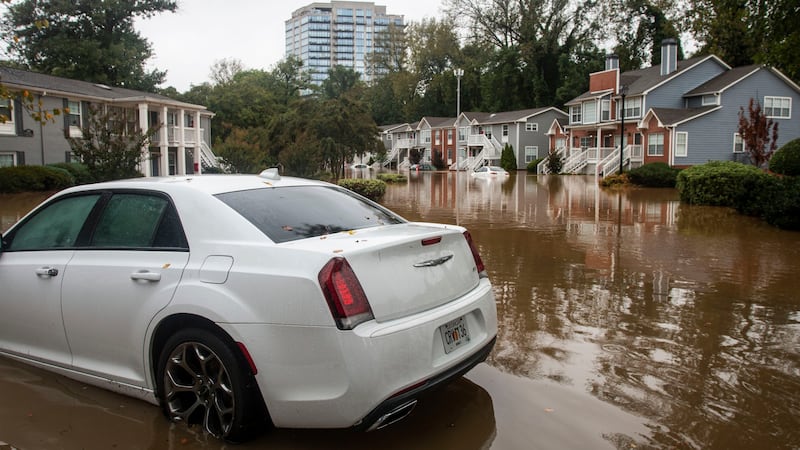ATLANTA — If your home was impacted by Tropical Storm Debby or Hurricane Helene, you may be able to get help with “temporary housing expenses, basic home repairs or other essential disaster-related needs that are not covered by insurance.” Gov. Brian Kemp declared a state of emergency ahead of the storm hitting week, and President Joe Biden declared a national emergency for parts of Georgia.
So how do you apply for federal assistance?
The easiest way is to go through FEMA’s website by visiting DisasterAssistance.gov.
If you do not have online access, you can call the FEMA helpline at 800-621-3362.
You can also schedule an in-person appointment to help with an application.
Read more HERE about applying.
What happens after I apply for FEMA assistance?
You will be contacted FEMA inspector within 10 days of applying for assistance to schedule an appointment for an inspection. The inspections will take about 30-40 minutes.
If FEMA is unable to get in touch, you will be sent a letter indicating your application cannot be processed further – to proceed, you must call FEMA’s Helpline at 1-800-621-3362 to confirm your contact information and need for assistance. There is no fee for the inspection.
Why do you need for a FEMA home inspection?
FEMA home inspections help determine whether a home is safe, sanitary, and livable, and to verify disaster-caused damage. Specifically, the FEMA inspector will:
- Verify your name, address, contact information, and insurance;
- Confirm the individuals living in your disaster-damaged residence; bedrooms occupied; clothing, medical, dental, transportation, or miscellaneous losses; and items you purchased as a result of the disaster (e.g., chainsaw, dehumidifier);
- Assess your pre-disaster residence’s structure, furniture, and appliances for damage caused by the disaster, as well as undamaged items;
- Document your pre-disaster residence’s square footage, foundation, and structural type (e.g., one or multiple stories). Record the cause of damage, applicable water levels, impacted utilities, and accessibility features; and
- Confirm with you that all damage has been viewed, and describe next steps in the FEMA process.
Not all losses require an inspection. You should also monitor your mail or your FEMA Online Account (www.disasterassistance.gov) and respond to any requests from FEMA for additional information quickly.
How do I know if the person at my door is a legitimate FEMA inspector?
Always ask an inspector for identification and never give out your personal information like your social security number. If you are not shown photo identification, then do not allow the inspection. Disasters often bring out scam artists who prey on the needs of disaster survivors. Government officials will never ask for money or other forms of compensation for the inspection.
What do I need to be prepared to show my FEMA inspector?
Have the following ready for your inspection:
- Photo identification. If you lost your id in the disaster, let the inspector know. FEMA has other ways to verify your identification.
- Proof of ownership/occupancy of damaged residence (structural insurance, tax bill, mortgage payment book/utility bill).
- Insurance documents: home and/or auto (structural insurance/auto declaration sheet).
- List of household occupants living in residence at time of disaster.
- All disaster-related damages to both real and personal property.
RELATED STORIES:
- Hurricane Helene: 95% of Georgians have power again, GA Power says
- Hurricane Helene: Drought conditions cleared out across North Georgia
- Hurricane Helene: Inside the North Carolina mountain town nearly wiped off the map
Can someone be there in my place?
Yes. You can have anyone like a trusted neighbor, family member or friend that is 18 years of age or older handle the inspection if you are unavailable.
What happens after the inspector visits?
Once the inspection process is complete, your case will be reviewed by FEMA, and you will receive a letter outlining the decision about your claim.
If you qualify for FEMA assistance, FEMA will send you a check by mail or deposit it directly into your bank account, depending on the method of payment you chose on your application. If you receive money for rental assistance, be sure to keep documentation and receipts of payments. If you pay to stay somewhere, you should have a written landlord/tenant agreement for the time frame you use the assistance.
If you do not qualify for a FEMA grant, you will receive a letter explaining why you may not be eligible and will be given a chance to appeal the decision. Your appeal rights will be described in the letter. Appeals must be in writing and mailed within 60 days of FEMA’s decision.
Can I appeal a decision?
You have the right to appeal any FEMA decision or award amount by sending documents that show you qualify and need more help, like estimates for repairs, receipts, bills, etc. Each decision letter you receive from FEMA explains types of documents that may help you appeal your FEMA’s decision or award amount for that type of assistance. Many times, an application is determined “not approved” because of missing documentation like proof of identity, proof of occupancy, proof the damaged property was your primary residence and others. For more information, visit: How to Appeal a FEMA Decision | FEMA.gov
How can I submit documentation?
You can visit DisasterAssistance.gov to upload your documentation online and check the status of your application online. You can also call 800-621-3362 for assistance or visit a Disaster Recovery Center.
What if I applied for FEMA assistance and was later evicted?
If you have already applied for FEMA assistance but were later evicted due to damage to other parts of your home, you should call the FEMA Helpline at 800-621-3362 or visit a local FEMA Disaster Recovery Center (DRC), if available.
You can contact FEMA even if you were previously not approved for FEMA assistance and FEMA may still be able to help. Check the FEMA App or visit the FEMA DRC Locator to find the locations and hours of operation. You will need to provide FEMA with documentation demonstrating your eviction was due to the disaster.
Do I need to pay FEMA back for any financial assistance I received?
No. In most cases, FEMA grants do not have to be paid back. If you have insurance that covers your temporary housing costs but ask FEMA to advance you some money to help you pay for those costs while your insurance is delayed, you will need to pay that money back to FEMA after you receive your insurance settlement.
FEMA assistance is not taxable income and won’t affect eligibility for Social Security, Medicare, Medicaid or Supplemental Nutrition Assistance Program (SNAP) benefits, or other federal benefits.
What if I can’t rebuild my house with the money FEMA is offering me?
FEMA Home Repair Assistance is limited and is intended to provide funds for basic repairs to make the home livable. It is not the same as insurance and in most cases, it cannot restore your home to its pre-disaster condition.
RELATED NEWS:
©2024 Cox Media Group







